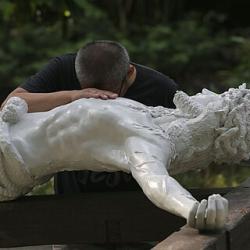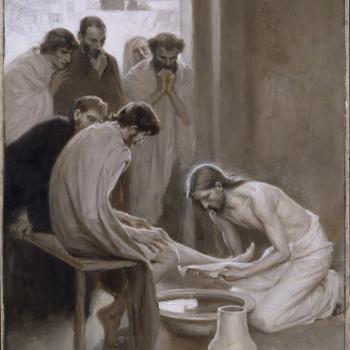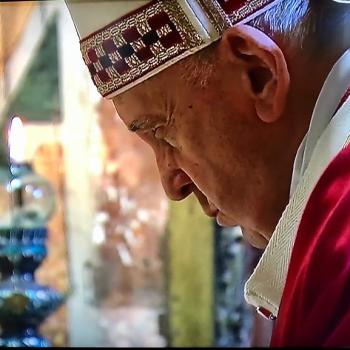But about that day and hour, no one knows, not even the angels in heaven, nor the Son, but only the Father. Jesus Christ
Your personal end of time is coming right at you.
Maybe that’s why people are so fascinated with any “end of time” prophecy they hear about. They know that their end of time will occur on that unknown but absolutely certain day when they die. They’d rather not have to face that day alone. They want the whole wide world to go with them.
My advice to people is to stop worrying about end of time prophecies and make sure that you are right with God today and every day. No end of time prophecy will be accurate. Jesus said so. He told us that no one knows the day or the hour. If you believe Jesus, then believe that. No. One. Knows.
The latest end of time babble centers around the supposed prophecies of St Malachy. Supposedly, St Malachy made a prophecy almost 1,000 years ago in which he detailed every pope up until now. He further said that “the last pope” would be — you guessed it — the one we just elected. This supposed prophesy is enough to send chills of delight up and down the spines of the oogidy-boogidy crowd. It also sets the typing fingers working on every pundit who’s looking for a story.
St Malachy was a real person and he is a real saint. But these so-called prophecies are, like every other end-of-time, the-anti-christ-is-coming fad we latch onto, malarky.
We have enough problems — real ones — to deal with as Christians. Let’s get to work on them.
Here’s a brief summary of the life of St Malachy from The Catholic Encyclopedia. Notice that it says the real St Malachy had the “gift of prophecy.” I don’t know what the means exactly, but I’m pretty sure it doesn’t mean soothsayer.
St. Malachy, whose family name was O’Morgair, was born in Armagh n 1094. St. Bernard describes him as of noble birth.
He was baptized Maelmhaedhoc (a name which has been Latinized as Malachy) and was trained under Imhar O’Hagan, subsequently Armagh. After a long course of studies/ by St. Cellach (Celsus) in 1119. In order to perfect himself in sacred liturgy and theology, he proceeded to Lismore, where he spent nearly two years under St. Malchus. He was then chosen Abbot of Bangor, in 1123. A year later, he was consecrated Bishop of Connor, and, in 1132, he was promoted to Armagh. St. Bernard gives us many interesting anecdotes regarding St. Malachy, and highly praises his zeal for religion both in Connor and Armagh. In 1127 he paid a second visit to Lismore and acted for a time as confessor to Cormac MacCarthy, Prince of Desmond. While Bishop, he continued to reside at Bangor, and when some of the native princes sacked Connor, he brought the Bangor monks to Iveragh, County Kerry, where they were welcomed by King Cormac. On the death of St. Celsus 1129, St. Malachy was appointed Archbishop of Armagh in 1132, which dignity he accepted with great reluctance. Owing to intrigues, he was unable to take possession of his see for two years; even then he had to purchase the Bachal Isu (Staff of Jesus) from Niall, the usurping lay primate.
During three years at Armagh, as St. Bernard writes, St. Malachy restored the discipline of the Church, grown lax during the intruded rule of a series of lay-abbots, and had the Roman Liturgy adopted.
St. Bernard continues: Having extirpated barbarism and re-established Christian morals, seeing all things tranquil he began to think of his own peace. He therefore resigned Armagh, in 1138, and returned to Connor, dividing the see into Down and Connor, retaining the former. He founded a priory of Austin Canons at Downpatrick, and was unceasing in his episcopal labours.
Early in 1139 he journeyed to Rome, Scotland, England,and France, visiting St. Bernard at Clairvaux. He petitioned Pope Innocent for palliums for the Sees of Armagh and Cashel, and was appointed legate for Ireland. On his return visit to Clairvaux he obtained five monks for a foundation in Ireland, under Christian, an Irishman, as superior: thus arose the great Abbey of Mellifont in 1142. St. Malachy set out on a second journey to Rome in 1148, but on arriving at Clairvaux he fell sick, and died in the arms of St. Bernard, on 2 November. Numerous miracles are recorded of him, and he was also endowed with the gift prophecy. St. Malachy was canonized by Pope Clement (III) on 6 July, 1199, and his feast is celebrated on 3 November.Here from The Bible Probe, is a short list of some of St Malachy’s “prophecies” about “the last pope.” This stuff has people who enjoy speculation about “the end days” enthralled. But from what I see here, you could make anybody fit these prophecies, including me, my Aunt Mattie and my cat. All we’d have to do is be elected pope, then you could rummage around in our lives and situations for something that might be stretched to the point that we could claim it “fulfilled” the “prophecy.”
St Malachy’s Prophecies – The Last 10 Popes The Burning Fire. PIUS X. 1903-1914. This Pope showed a burning passion for spiritual renewal in the Church./p> <Religion Laid Waste (Religio Depopulata). BENEDICT XV. 1914-1922. Unfortunately, this was true. During this Pope’s reign saw Communism move into Russia where religious life was laid waste, and World War I with the death of millions of Christians who were carnage in Flanders Field and elsewhere. Unshaken Faith. >PIUS XI. 1922-1939. This Pope faced tremendous pressure from fascist and sinister powers in Germany and Italy, but he was an outspoken critic of Communism and Fascism which enraged Hitler. An Angelic Shepherd. PIUS XII. 1939-1958. This Pope had an affinity for the spiritual world and received visions which have not been made public. Peter Bander says Pius XII “has emerged as one of the great Popes of all time,” and he “was in the truest sense of the word an Angelic Pastor to the flock…” Pastor and Mariner. JOHN XXIII. 1958-1963. ” Pastor et Nauta” or “Pastor and sailor”. John was a pastor to the world, much beloved, and the Patriarch of Venice. The connection to “mariner” is thus remarkable. According to Peter Bander in The Prophecies of Malachy (TAN Books and Publisher, 1969 during the conclave which was to elect John XXIII in 1958, a certain Cardinal from the United States, (Cardinal Spellman of New York) evidently having taken Malachy’s forecast that the next pope would be “pastor and mariner” literally, rented a boat, filled it with sheep and sailed up and down the Tiber.6. Flower of Flowers. “Flos Florum” AUL VI. 1963-1978. Paul’s coat-of-arms depicts three fleurs-de-lis, corresponding to Malachy’s prophecy. His coat of arms included three fleurs-de-lis (iris blossoms). At the popular and controversial site of Garabandal in Spain, a seer named Conchita Gonzalez once noted: “The Blessed Virgin said in 1962 that there will only be two more popes after Paul VI.” Of the Half Moon. “De Medietate Lanae,” or “from the half moon” JOHN PAUL I. 1978-1978. John Paul I was elected Pope on August 26, 1978, when there was a half moon. He reigned 33 days, that is, about one month, when he died, although many think he was murdered. He was the 109th Pope – is “De Medietate Lunae” (Of the Half Moon). The corresponding pope was John Paul I (1978-78), who was born in the diocese of Belluno (beautiful moon) and was baptized Albino Luciani which means white light, such as that given off by the half-moon in Malachy s prophecy. He became pope on August 26, 1978, when the moon appeared exactly half full. It was in its waning phase. He died the following month, soon after an eclipse of the moon. The Labor of the Son. “De Medietate Lunae” JOHN PAUL II. 1978-2005 Amazingly, Pope John Paul II was the only pope who was both born the day of an eclipse of the sun, and entombed the day the sun was eclipsed. The Glory of the Olive. The Order of St. Benedict has said this Pope will come from their order. It is interesting that Jesus gave his apocalyptic prophecy about the end of time from the Mount of Olives. PETER THE ROMAN – The 112th prophesy states: “In the final persecution of the Holy Roman Church there will reign Petrus Romanus, who will feed his flock amid many tribulations; after which the seven-hilled city will be destroyed and the dreadful Judge will judge the people. The End.” The last pope may just cut Catholics loose from unity and the papacy, causing total disruption and confusion. See Saint Francis of Assissi’s 13th century prophecy below. It is believed the next pope will be the last pope.












